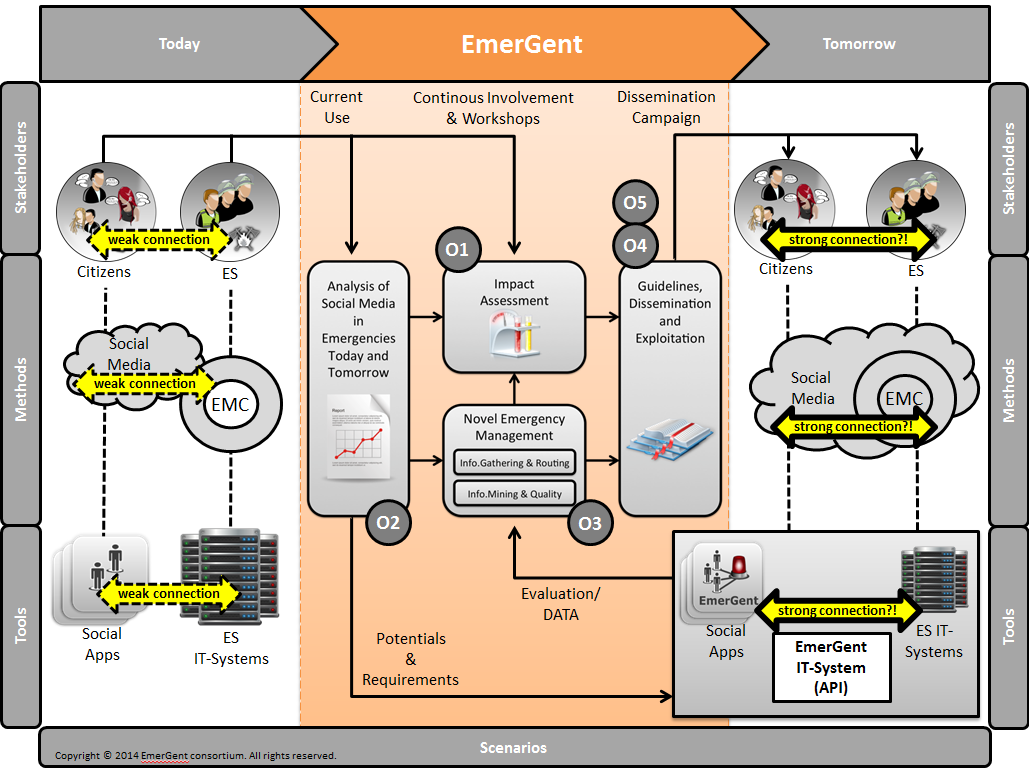That’s EmerGent
The EmerGent IT-System Architecture
not available any more!
Due to the time that has passed, many external links are no longer accessible. We apologise for this, but unfortunately we cannot guarantee any further maintenance at this time.
Background
Social media is a serious and fast growing phenomenon for creating and maintaining social links. The convergence of social networking and mobile media technology is also shifting the way people communicate, and gain or share information, especially during emergency or crisis situations. Thus social media and especially social network providers like Facebook and Twitter create impactful content when citizens share their observations, opinions and emotions, and this is not restricted to normal life events. During catastrophes throughout the world, like the Loveparade disaster 2010 in Germany or hurricane Sandy 2012 social media have been widely used. Wherever emergencies or crises occur, ad-hoc communities are built through existing social media channels. But these communities are often not connected at all or perhaps are weakly connected to the emergency management services (EMS) and the corresponding emergency management processes. Hence a systematic research project concerning the effective identification and integration of valuable and reliable information from social media into emergency management processes is needed.
The overall objective of EmerGent is to understand the positive and the negative impact of social media in emergencies in order to:
- enhance objective and perceived safety and security of citizens before, during and after emergencies,
- strengthen the role of European companies supplying services and products related to EmerGent’s results.
The EmerGent concept & objectives
The overall concept of EmerGent is shown in the figure below. Today the “emergency management cycle” (EMC) with its phases does not capture social media (represented by the cloud on the left hand side) with its highly valuable information. Although existing social apps (e. g. for mobile devices) are sometimes used by citizens to share their observations and feelings, these are only weakly connected to existing EMS systems. To achieve the goal of EmerGent (right hand side in the figure) the consortium has developed a strong research oriented methodology (centre of figure).

The overall concept
Within the “Analysis of Social Media in Emergencies Today and Tomorrow” (O2), EmerGent investigates the current use of social media during emergencies, and the future potential for citizens and EMS involvement within the EMC when using social media. It also performs an analysis of the methods and tools for citizens and EMS to integrate on a technical level.
The results of the analysis are used to assess the impact of social media in emergencies for citizens and EMS (O1) through continuous citizen and EMS involvement through social media and workshops. This includes the acquisition of users who participate long-term as well as the development of basic infrastructures to maintain and support relationship via social media. The methodology of the impact assessment consists of case studies, analyses of emergencies in the past where social media played a crucial role, workshops with experts and deep content analysis to get precise knowledge about feelings and reactions on both sides.
To handle the vast amount of valuable and distributed information, methods for Information Mining (IM) and Information Quality (IQ) are developed to classify and rate the available and provided data from users. Information Gathering (IG) and Information Routing (IR), including the development of new social apps, is done as part of the “Novel Emergency Management” (O3). The development of new social apps is undertaken to obtain and provide visualisations of the most relevant information (as assessed by EmerGent) integrated with several social network providers.
All analysis and impact assessment results lead to the creation of guidelines (O4). These guidelines enable EMS and all other involved stakeholders to understand the benefits of social media and its integration into their process on different levels (conceptual & technical) (O5). The insights and results from the studies are incorporated into these guidelines. Through the collection and presentation of Information, the analysis of social media in emergencies and the development of IM and IQ methods, an IT-system for the “Novel Emergency Management in Social Media Generation” will be developed.
